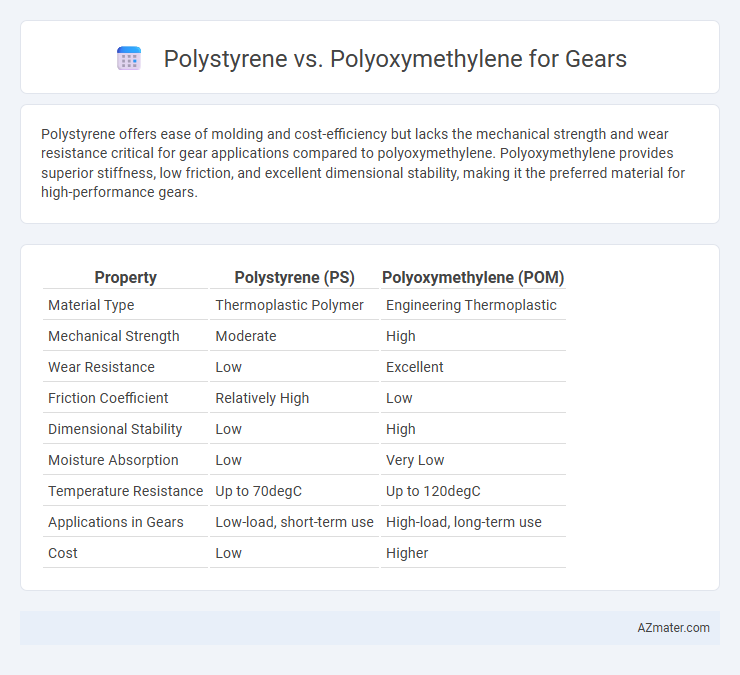Polystyrene offers ease of molding and cost-efficiency but lacks the mechanical strength and wear resistance critical for gear applications compared to polyoxymethylene. Polyoxymethylene provides superior stiffness, low friction, and excellent dimensional stability, making it the preferred material for high-performance gears.
Table of Comparison
| Property | Polystyrene (PS) | Polyoxymethylene (POM) |
|---|---|---|
| Material Type | Thermoplastic Polymer | Engineering Thermoplastic |
| Mechanical Strength | Moderate | High |
| Wear Resistance | Low | Excellent |
| Friction Coefficient | Relatively High | Low |
| Dimensional Stability | Low | High |
| Moisture Absorption | Low | Very Low |
| Temperature Resistance | Up to 70degC | Up to 120degC |
| Applications in Gears | Low-load, short-term use | High-load, long-term use |
| Cost | Low | Higher |
Introduction to Engineering Plastics in Gear Manufacturing
Polystyrene and polyoxymethylene are common engineering plastics used in gear manufacturing, each offering unique mechanical properties suited for specific applications. Polystyrene provides good dimensional stability and ease of fabrication but lacks the strength and wear resistance required for high-load gear operations. Polyoxymethylene (POM) excels with high stiffness, low friction, and excellent fatigue resistance, making it the preferred choice for precision gears demanding durability and smooth performance.
Overview of Polystyrene: Properties and Applications
Polystyrene is a versatile thermoplastic polymer known for its rigidity, clarity, and ease of processing, making it suitable for applications requiring dimensional stability and low friction. Its moderate tensile strength and low moisture absorption provide consistent performance in light-duty gears, particularly in consumer electronics and household appliances. Polystyrene's cost-effectiveness and good electrical insulation properties further enhance its suitability for non-load-bearing gear components where precision and surface finish are critical.
Understanding Polyoxymethylene (POM): Characteristics and Uses
Polyoxymethylene (POM), also known as acetal, is a highly crystalline thermoplastic renowned for its exceptional stiffness, low friction, and excellent dimensional stability, making it ideal for precision gear applications. Unlike polystyrene, POM offers superior wear resistance, high tensile strength, and outstanding chemical resistance, which ensure longer gear life and reliable performance under mechanical stress. Its low moisture absorption and excellent fatigue resistance contribute to smooth operation and durability in automotive, industrial machinery, and consumer electronics gears.
Comparative Mechanical Strength: Polystyrene vs POM
Polyoxymethylene (POM) demonstrates superior mechanical strength compared to Polystyrene, exhibiting higher tensile strength and enhanced impact resistance ideal for precision gear applications. Polystyrene, while more economical, has lower durability and brittleness under mechanical stress, limiting its use in load-bearing gear components. POM's excellent wear resistance and dimensional stability under strain make it the preferred choice for gears requiring long-term reliability and performance.
Wear Resistance and Durability in Gear Applications
Polyoxymethylene (POM) exhibits superior wear resistance and durability compared to polystyrene, making it ideal for high-performance gear applications subjected to continuous mechanical stress. POM's low coefficient of friction and high tensile strength contribute to enhanced dimensional stability and prolonged service life in gears. Polystyrene, by contrast, tends to have lower impact resistance and wears out faster under repetitive load conditions, limiting its suitability for demanding gear components.
Dimensional Stability and Precision Performance
Polyoxymethylene (POM) offers superior dimensional stability and precision performance compared to polystyrene, making it ideal for gears requiring tight tolerances and low friction. POM's crystalline structure ensures minimal shrinkage and excellent wear resistance, maintaining consistent gear geometry under varying loads and temperatures. Polystyrene, while easier to mold, exhibits higher thermal expansion and lower mechanical strength, leading to reduced precision and potential deformation in gear applications.
Chemical and Thermal Resistance Differences
Polystyrene offers moderate chemical resistance but degrades when exposed to strong solvents and elevated temperatures above 80degC, limiting its suitability for high-stress gear applications. Polyoxymethylene (POM) demonstrates superior chemical resistance, tolerating exposure to fuels, oils, and solvents while maintaining dimensional stability and mechanical strength up to 100-120degC. The enhanced thermal resistance and chemical inertness of POM make it a preferred material for precision gears operating in chemically aggressive and high-temperature environments.
Cost-Effectiveness and Material Availability
Polystyrene offers lower material costs and broad availability, making it a cost-effective option for gears requiring moderate strength and rigidity. Polyoxymethylene (POM), while more expensive, provides superior mechanical properties, wear resistance, and dimensional stability, justifying its cost for high-performance gear applications. The choice depends on balancing budget constraints with the operational demands of the gear system.
Environmental Impact and Recyclability
Polystyrene exhibits lower environmental sustainability due to its non-biodegradable nature and limited recyclability, often ending up in landfills and marine environments. Polyoxymethylene (POM), also known as acetal, offers better recyclability through mechanical recycling and has a longer lifespan, reducing overall environmental impact in gear applications. However, both materials rely on petrochemical feedstocks, emphasizing the need for improved recycling technologies and potential bio-based alternatives.
Choosing the Right Material: Key Factors for Gear Selection
Polystyrene offers excellent dimensional stability and ease of molding but lacks the mechanical strength and wear resistance needed for high-performance gear applications. Polyoxymethylene (POM), also known as acetal, provides superior tensile strength, low friction, and outstanding wear resistance, making it ideal for precision gears requiring durability and smooth operation. Selecting the right gear material depends on factors such as load capacity, operating environment, required lifespan, and frictional characteristics, with POM being the preferred choice for demanding mechanical applications.

Infographic: Polystyrene vs Polyoxymethylene for Gear
 azmater.com
azmater.com